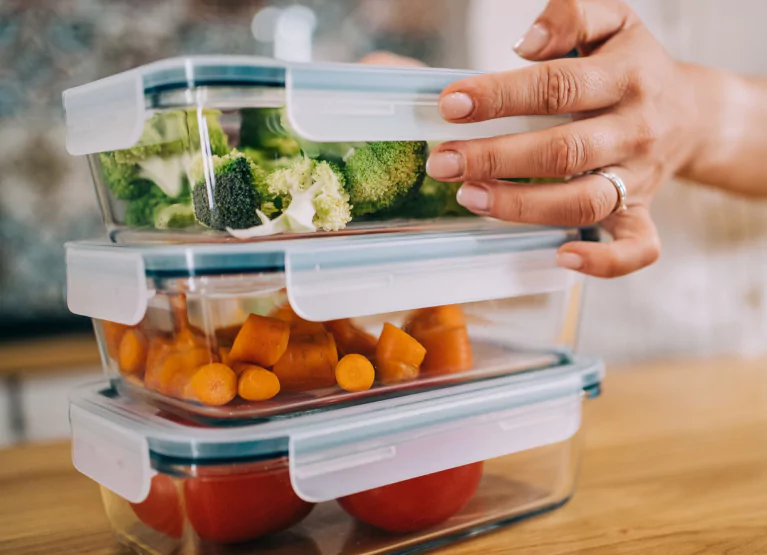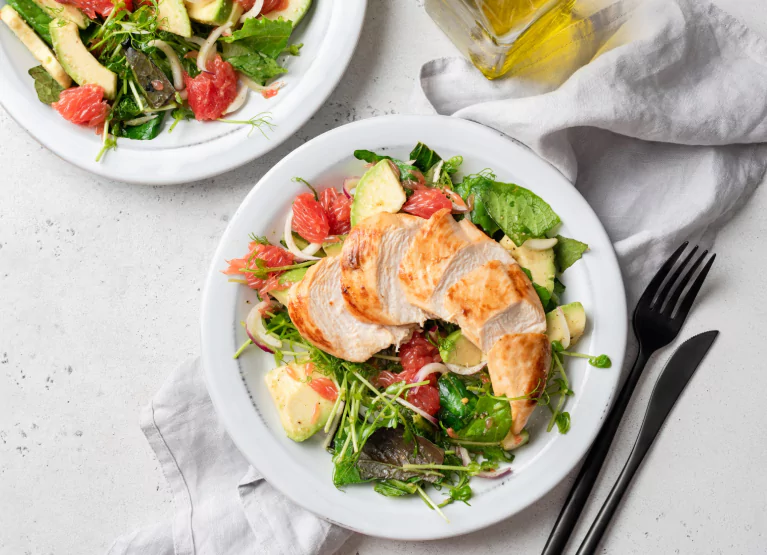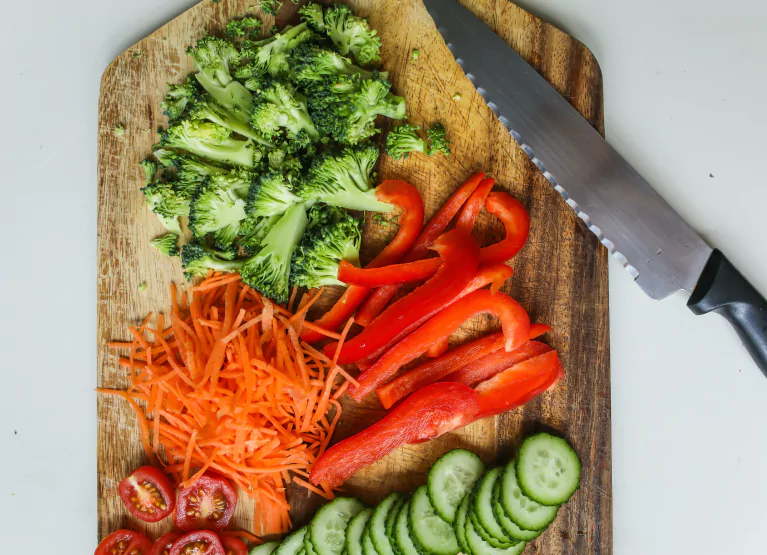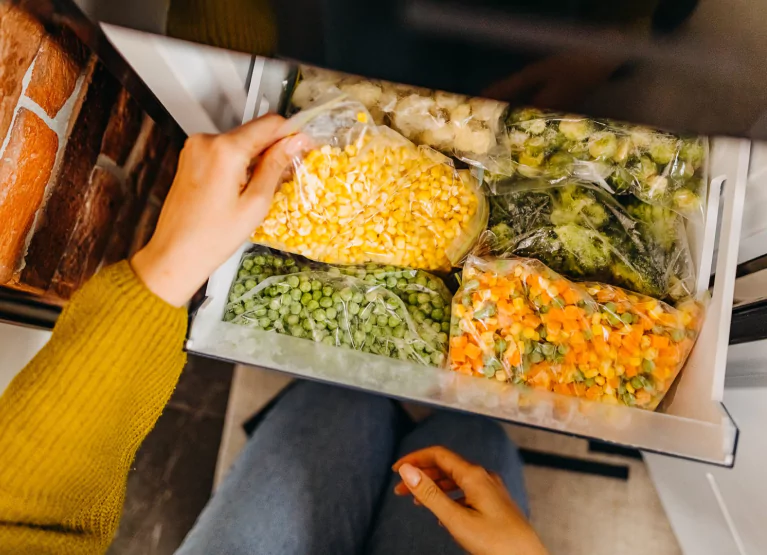Are Frozen Meals Healthy?

Key Takeways
If you're in a pinch, warming up a frozen pizza or a microwave dinner can sometimes be a quick and convenient option. And a few frozen meals won't be terrible for you in a pinch! However, these types of ready-made meals don't have a reputation for being the healthiest options.
But what is it about frozen meals that's important to look out for while you're perusing the frozen food aisle? While they can be an easy way to eat a balanced meal without all the prep, cooking, and washing up, they may also have hidden ingredients, preservatives, excessive calories, sodium, and trans fats.
In this article, we'll tell you what to look for and how to balance convenience and health. We'll also share some dietitian-approved, healthy frozen meal choices you may want to consider.
Are Frozen Meals Healthy?
They can be! When it comes to frozen foods, especially whole food ingredients like flash-frozen vegetables and fruits, you don't have to worry as much about whether they're retaining their nutrients.
But are frozen meals bad for you? The answer is slightly more complex, depending on various factors. After all, so many types of frozen meals are available, and not all are created equal. Frozen meals make it easy to heat up anything from macaroni and cheese to chicken enchiladas within minutes. However, some of these are often highly processed, may be higher in calories, and contain harmful additives you may want to limit in your diet.
For example, as with other ultra-processed foods, frozen meals can contain additives that may increase your risk of certain cancers. Some frozen foods like pizza or pizza pockets may also contain trans fats, which may have some links with poorer heart health.
Many frozen meals and processed foods are also often high in sodium, added sugars, and saturated fats, so you'll want to read the nutritional information of your chosen meal carefully. Some studies also show a link between frozen and ready-made meals and an increased risk of obesity.
It's important to note that the nutritional content of your frozen meal can also depend on the brand and the type of food. Some frozen meals may be high in protein or low in carbohydrates, which can be convenient if you're following a ketogenic diet.
Other Factors to Consider For Healthy Frozen Meals

Our team of credentialed dietitians and nutritionists at Nutrisense recommends looking for frozen options that include whole grains, fiber, and protein. This is one way to help ensure that your frozen entree is healthier. Meals with nutritious foods such as sweet potatoes, quinoa, brown rice, lean proteins such as chicken, and leafy greens or vegetables like zucchini or green beans can be a great place to start.
If you regularly stock up on frozen dinners, you may also want to identify brands that don't use harmful additives, trans fats, or low-sodium meals. You could find some good options at stores like Whole Foods and Trader Joe's, which we'll discuss later in this piece.
What to Avoid in a Frozen Meal
As with any food you're including in your diet, it's good to be aware of its ingredients. While not all frozen meals are necessarily unhealthy, the quality and ingredients can also help determine their healthiness.
When searching for some healthier frozen meal options, you'll want to opt for brands that don't include the following ingredients in their products:
Trans Fat and Partially Hydrogenated Oils
Most popular frozen meals and fried foods typically contain at least some trans fat. The Nutrisense dietitian team recommends avoiding or limiting your consumption of trans fat, as some research shows a possible link between this fat and high cholesterol, poor cardiovascular health, and heart disease. Check your frozen meal's package label to ensure it doesn't include this type of fat.
Amanda Donahue, MS, RD, CD, explains how to look for this on your nutrition labels: “As per FDA guidelines, fats must be listed separately, even if other fats like mono and polyunsaturated fats aren't mentioned. If a serving has less than 0.5 grams of trans fat, for example, it's typically labeled as 0 g. If a product has multiple servings, even if it has 0.5 grams (but is labeled as 0 grams), it can be misleading, and this can start to add up in your meals. There's some nuance here, too: for foods with less than 0.5 grams of total fat per serving and no fat-related claims, they can skip the "0 g" and just say, "Not a significant source of trans fat" on the label.”
Low Fiber Content

Adequate fiber intake can support healthy immune function, glucose regulation, insulin sensitivity, and feelings of fullness (which prevents you from both over and undereating).
Interestingly, increasing dietary fiber may also be linked to improved weight loss outcomes. Unfortunately, many frozen meals are low in fiber, though the type of meal you choose can also determine its fiber content.
Opting for frozen meals that include plenty of fiber in each meal or adding extra sources of fiber on the side can help you reap some of these health benefits.
Additives and Colorings
Some food dyes and colorings may be associated with negative health consequences. A paper on the toxicology of dyes found blue, red, and yellow dyes may lead to hypersensitivity reactions in some people (this is when your immune system overreacts to or identifies a harmless substance as harmful), and some have tested positive for genotoxicity (or the ability of certain chemicals to damage genes).
Some additives and preservatives may also interfere with the levels of certain vitamins and minerals in your body. For example, consuming phosphoric acid, a common additive, can be a risk factor for hypocalcemia or extremely low calcium levels in postmenopausal women.
Another common frozen food additive is butylated hydroxyanisole (BHA), which is known as an endocrine disruptor and may have other health risks. However, most research has been on mice, and more studies are necessary to draw further conclusions.
High Sodium Content

It's essential to watch out for sodium content when you're reading the nutritional information of your favorite frozen meal. Frozen meals tend to be higher in sodium, with some reaching up to 40 percent of your daily recommended intake in just one meal. High salt content intake has links to high blood pressure, which may be a precursor for heart disease and stroke in those who are salt-sensitive.
Five Healthier Frozen Dinners Recommended by a Nutritionist
Now that we've uncovered some things to look out for when shopping for frozen meals, nutritionist Amanda Donahue, MS, RD, CD, recommends some healthier options you may want to consider the next time you're in a hurry.
Remember to look at the nutrition labels of the food you are choosing. You can also consult a registered dietitian or nutritionist for further advice based on your health needs.
1) Frozen Wood-Fired Pizza from Whole Foods
Nutritional Info to Note:
- 490 calories
- 17 grams of fat
- 38 grams of carbohydrates
- 3 grams of fiber
- 8 grams of protein
A hand-crafted pizza with simple food ingredients, lean protein, and veggie toppings can be a good option. There are a lot of different frozen pizza varieties to choose from, but you'll want to look for one that doesn't include trans fat.
One option is the Whole Foods Pizza and Hummus-Kale, which contains sunflower seed oil, olive oil, and veggies like kale and eggplant. This option also includes three grams of fiber and eight grams of protein per serving.
If you're sensitive to gluten and/or dairy, you may want to choose another option like the Cauliflower Plant-Based Cauliflower Crust. This thin crust has really simple ingredients, is gluten-free and vegan, and is super easy to top with sauce, cheese, and toppings.
Pair your pizza with a healthy fat like avocado or snack on extra veggies for added fiber. You can add extra protein toppings, such as grilled chicken, to help blunt your glucose response. Going for a short walk after your meal can also benefit blood sugar levels.
2) Basil Pesto Chicken Power Bowl from Healthy Choice

Nutritional Info to Note:
- 290 calories
- 9 grams of fat
- 17 grams of carbohydrates
- 7 grams of fiber
- 20 grams of protein
If you're on the go, having a high-protein meal on hand is always nice. Healthy Choice's Basil Pesto Chicken meal has protein, vegetables, fats, and delicious herbs.
This dish is low in carbs, high in protein, and contains just 290 calories, which makes it a great frozen meal option. To make this dish even better, try adding more veggies on top or even on the side. It can be as easy as grabbing some frozen veggies at the grocery store and heating them with the meal.
3) Keto Steak Chili with Refried “Beans” from 518 Kitchen
Nutritional Info to Note:
- 800 calories
- 68 grams of fat
- 18 grams of carbohydrates
- 8 grams of fiber
- 34 grams of protein
A frozen burrito or wrap is a classic frozen food item. Unfortunately, some wraps or burritos contain more processed foods and are high in carbs. Luckily, some options may be slightly better in terms of nutrition.
One of these options is Keto Steak Chili with Refried "Beans" from 518 Kitchen. This plate is similar to a deconstructed burrito and is keto-friendly. It contains 34 grams of protein and eight grams of fiber and sits at 800 calories.
While this type of meal can be quite satiating due to its protein, fat, and fiber content, it's important to note that it is higher in fat, contributing to its higher calorie count, so you may want to be careful with your portion size. Try cutting the meal in half to make two portions, and add some non-starchy vegetables to add bulk to the meal and increase nutrient density without too many extra calories.
4) Chicken Pesto from Primal Kitchen
Nutritional Info to Note:
- 460 calories
- 39 grams of fat
- 10 grams of carbohydrates
- 5 grams of fiber
- 18 grams of protein
This chicken pesto and cauliflower rice meal from Whole Foods is another great frozen meal with minimal ingredients. It is also dairy-free (a good option for those who are lactose intolerant or avoiding dairy) and contains 18 grams of protein and just 490 calories.
The meal also contains five net grams of carbs, making it an excellent option for anyone following a keto diet. The mix of protein, fats, and fiber makes this dish a perfect go-to for a blood sugar-friendly option to have in your freezer.
5) Grilled Chicken Caesar from Lean Cuisine
Nutritional information to note:
- 260 calories
- 8 grams of fat
- 28 grams of carbohydrates
- 2 grams of fiber
- 19 grams of protein
This frozen meal from Lean Cuisine is a popular choice, for good reason. You’ll find it in most stores and it’s pretty healthy, so it’s a great, accessible option for when you need a meal in a hurry.
With 19 grams of protein and only 260 calories per serving, it provides a satisfying, nutritious meal. Including broccoli adds some fiber and vitamins, making it a well-rounded choice.
Make DIY Frozen Meals

If you have a bit of extra time and can tolerate some advance meal prepping, another great way to ensure your frozen meal is healthier is to DIY it. This can be as easy as throwing a few of your favorite ingredients in a storage box like Tupperware and storing them for the future.
To do this, start by grabbing your favorite fresh food ingredients. You can opt for a frozen vegetable medley from your local grocery store to make it easier. Next, you can add a carb source such as brown rice or precooked potatoes. If you're eating low-carb, omit this step and simply add more veggies or fat.
Finally, choose a frozen protein source of choice, such as chicken, fish, or tofu, and finish your meal by adding a healthy fat source like olive oil, nuts, and seeds. You can also top it with fresh avocado and any additional spices you like. It takes a little advance prep, but it makes daily meals a hassle-free experience. Plus, you'll know exactly what you're getting every time.
If you're a beginner in the kitchen, don't worry! There are plenty of easy meal prep recipes available online. Another great option is to order meal-prepped kits. Many companies offer this type of service, such as Hello Fresh, Fresh Meal, Buddha Bowl, Blue Apron, and Home Chef.
These services will provide you with pre-portioned fresh ingredients and recipes to help you cook healthy, balanced meals at home.
Find the right Nutrisense programto turn insight into progress.
Experiment with Frozen Foods Meals with Nutrisense
Although frozen meals can be convenient, it's essential to monitor your blood glucose levels and make sure you're making smart nutrition choices. Instead of guessing which frozen meals are best for you, consulting a registered dietitian or nutritionist is an excellent way to shortlist some good choices. Then, you can track your glucose response to them using a continuous glucose monitor (CGM).
When you sign up for the Nutrisense CGM program, you can work 1:1 with credentialed nutritionists and dietitians to help you navigate your data and make informed decisions about your nutrition.
You can work with an expert to personalize your diet based on your unique glucose responses. Plus, with our easy-to-use app, you'll have all the data and resources at your fingertips.
Ready to take the first step? Start with our quiz to see how Nutrisense can support your health.
Go Beyond Glucose Data with Nutrisense
Your glucose can significantly impact how your body feels and functions. That’s why stable levels are an important factor in supporting overall wellbeing. But viewing glucose isn't enough. Nutrisense, you’ll be able to learn how to use your body's data to make informed lifestyle choices that support healthy living.
One-to-one coaching
Sign up to access insurance-covered video calls to work with a glucose expert: a personal registered dietitian or certified nutritionist who will help tailor your lifestyle and diet to your goals.
Monitor and measure what matters
With the Nutrisense CGM Program, you can monitor your glucose with health tech like glucose biosensors and continuous glucose monitor (CGM)s, and analyze the trends over time with the Nutrisense App. This will help you make the most informed choices about the foods you consume and their impact on your health.
Find your best fit
Ready to take the first step? Start with our quiz to find the right Nutrisense program to help you take control.

Heather is a Registered and Licensed Dietitian Nutritionist (RDN, LDN), subject matter expert, and technical writer, with a master's degree in nutrition science from Bastyr University. She has a specialty in neuroendocrinology and has been working in the field of nutrition—including nutrition research, education, medical writing, and clinical integrative and functional nutrition—for over 15 years.




